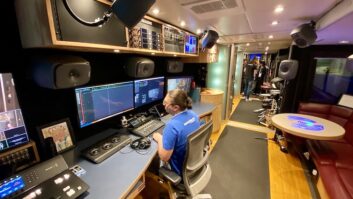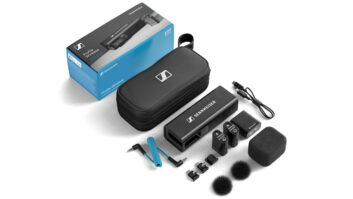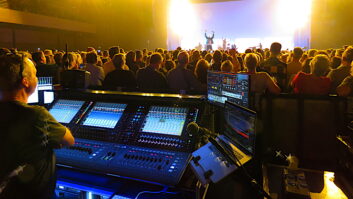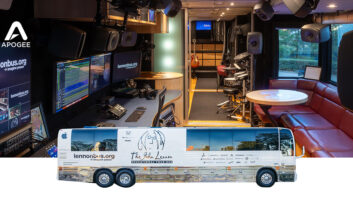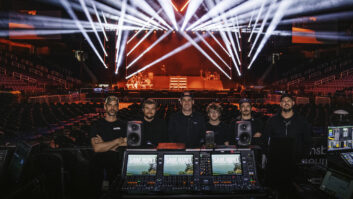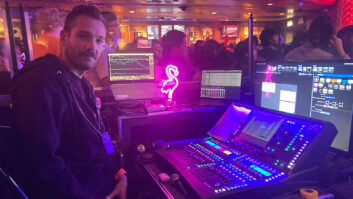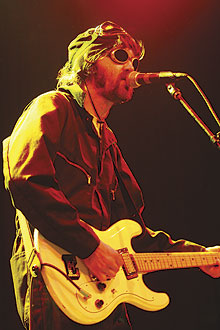
photo: Steve Jennings
As the crowd finishes their drinks and makes their way to the Fillmore Auditorium’s (San Francisco) main floor, the retro lounge intermission music gives way to an ear-splitting wall of dissonant noise. Clearly, this will not be one of The Eels’ quieter shows.
A departure from the 2005 Eels With Strings tour that supported their latest album, Blinking Lights and Other Revelations, The Eels current No Strings Attached Tour offers up much of the same material, but with amplified guitars rather than a string quartet, celeste, pump organ, melodica and lap steel. They’re playing U.S., Canadian and European dates with two guitars, drums, keyboards and gruff vocals courtesy of frontman Mark Oliver Everett, aka E. A tattooed, mutton-chopped bouncer/boxer/good vibes generator named Krazy Al completes the lineup. With Krazy Al posturing on stage right and no bass guitar to be found, it’s still an unusual assemblage, but it’s about as close to a standard rock ‘n’ roll setup as this band gets.
Front-of-house engineer Kevin Madigan and monitor engineer Montaigne Benoit kept the needle in the middle with a pair of 64-channel DiGiCo D1 consoles supplied by Sound Image. Madigan says that the compact console gives him more than enough inputs for The Eels and support act Smoosh without any repatching.

Front-of-house engineer Kevin Madigan stands guard at his DiGiCo D1.
“I multitrack record every night’s show with a MADI recorder, fed post-gain, pre-EQ from the D1,” says Madigan. “I can play the recordings back through the console, channel for channel, with the relevant snapshot settings, which allows me to work on my soundcheck without the band being there. I also split the vocals into the D-Tube DiGiCo valve input section, which, when pushed hard, creates an overdriven effect for vocals. It works very well, sounds great and saves on having to carry any outboard gear.”
Relying on the D1 for effects and EQ and the venue for P.A. allows the band to travel with less gear and fewer “kinks” to sort out. Madigan uses SIA Smaart software and the D1’s parametric processors to ensure each P.A. is optimized and aligned; a Meyer M3D powered line array is flown at The Fillmore. The more standard instrumentation makes for a straightforward mix. “It’s a rock ‘n’ roll — type mix that needs to be upfront, solid and aggressive,” says Madigan. “The levels are quite high, but it’s not horrendously hard to get on top of. The low end comes from either E’s baritone guitars or from an octave pedal on Chet’s guitar.”
Going for an open-sounding yet high-impact feel for the drums, Madigan uses an Audix D6 on the kick. He uses Audix Micro-Ds to mike the toms and i5s to capture snare (top and bottom), and ADX-51 condenser mics are used on hi-hats and overheads.

Monitor engineer Montaigne Benoit is also on a
DiGiCo D1.
Mesa Boogie amps and Fender Bandmaster cabinets, miked with Shure KSM 27 and 57s, respectively, power the guitars. Madigan uses Audix OM7 at front-center on E’s vocals “to get a little bit more stage noise rejection and better level control onstage,” the FOH engineer says. “Monitor levels are quite high!”
Back in monitor world, engineer Benoit relies on the venue’s Meyer MSL3s for sidefills and Meyer 2×15 subs paired with Meyer MSL-2As for two mixes. The DiGiCo takes care of any EQ and compression needed. Benoit uses Sound Image G2 wedge monitors for E’s guitars and the Hammond B3, while the rest of the band listens through The Fillmore’s Meyer wedges. As for using in-ears, “We’re not there yet,” she says. “Everybody wants to hear themselves and whatever instruments they use to cue off of, which took some of the pressure off for those first few shows. The learning curve came from navigating the DiGiCo. It takes a little bit of work to go from an analog mindset to digital thinking, but it’s become really convenient. If something works one night, you just save it and it’s in there for the next show.”
Heather Johnson is a Mix contributing editor.

